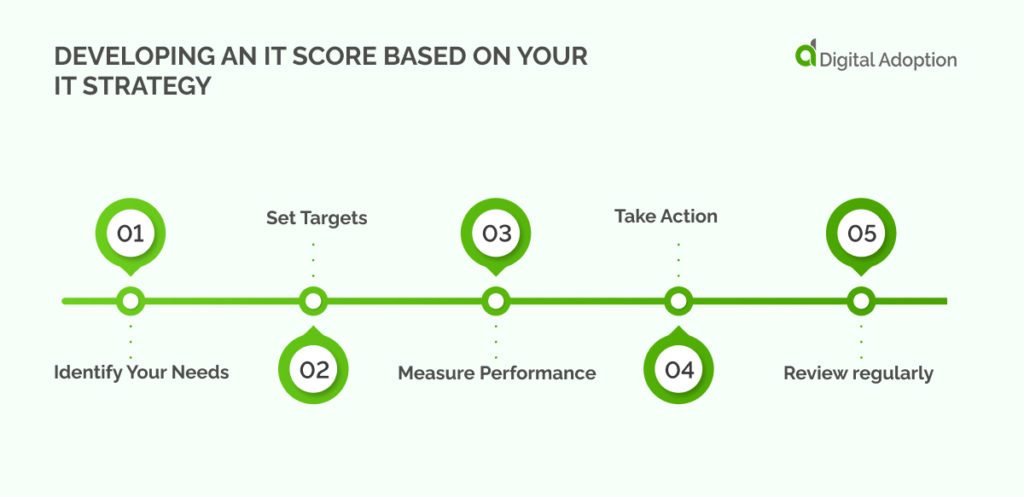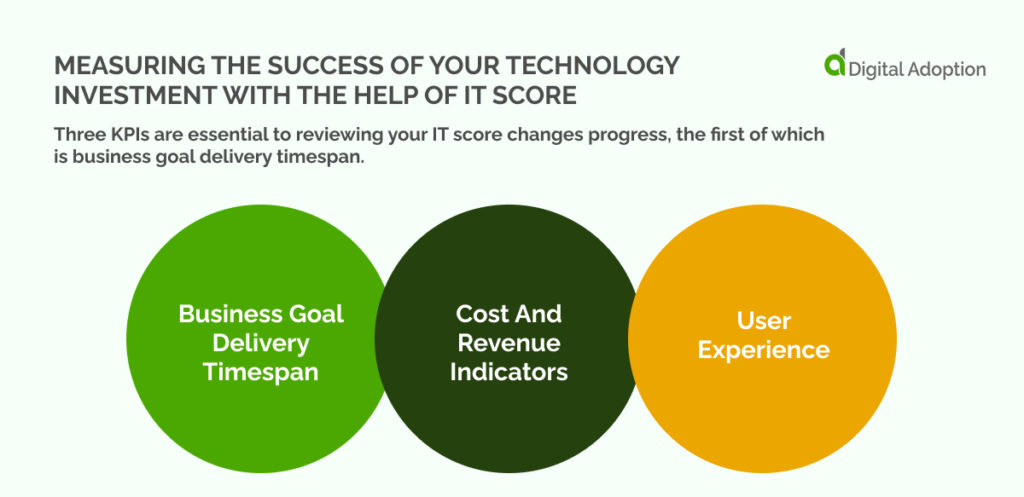Keeping an IT score is essential to IT leaders & CIO’s as it helps define their current IT model, identify if it aligns with the company goals, and ensure steady growth and ROI.
Since data is at the core of all IT operations, it is essential to ensure IT operates at the optimal level at all times to collect and utilize the data on which the success of your business depends.
This is where the IT score comes in.
This article will examine an IT score, why it is essential, how to find the right IT score for your leadership style and many other aspects of this crucial tool. Let’s begin with a definition.
- What Is An IT Score?
- Why Is an IT Score Important?
- IT Score For Different Types of Data Leaders
- Developing an IT Score based on your IT Strategy
- Establishing Effective Governance with IT Score
- Implementing Change Management with IT Score
- Measuring the Success of Your Technology Investment with the Help of IT Score
- Calculate Your IT Score Today
What Is An IT Score?
An IT score calculates the effectiveness of your information and technology (IT) model, such as operations and technology, about a company’s digital objectives. The IT score assessment digital tools help you determine areas that need improvement and capitalize on market opportunities, from leveraging cutting-edge technological solutions to optimizing user experience and reducing operational costs.
Why Is an IT Score Important?
Before producing an IT score, consider why it is essential for your business. When a data leader, such as a CIO (chief information officer), uses an IT score, they can assess the level of maturity and importance of every single part of their IT model, giving them the data to prioritize the weaker elements and use the IT score to improve the IT model ensure excellent operations at every level.
Without an IT score, IT operations would degrade in quality over time, delaying systems for employees and reducing revenue, which harms company growth and success. IT score is also identified as one of Gartner’s digital adoption trends for 2023.
The first step to using an IT score is understanding how it works for your field of leadership.
IT Score For Different Types of Data Leaders

IT score is helpful for CIOs and many other types of leaders in many data fields, such as data and analytics, applications, infrastructure, and operations. Chances are, if you work with data in any context, knowing your IT score will benefit you.
1. Data and Analytics Leaders
The chief analytics officer (CAO) is responsible for the partnership between data collection and business intelligence models, meaning that being aware of the IT score of the company is essential. They collaborate with the CIO to build a robust infrastructure that allows analytics to take place efficiently. Data acquired during the IT score process augments the CAO-CIO relationship as it will enable them to decide on improving data practices within IT.
2. Chief Information Security Officers (CISOs)
Serving as the bridge between security and business interests, a Business Information Security Officer (BISO) is a high-level cyber security role that aligns strategies with objectives, so they must be knowledgeable about the IT score to optimize data security practices.
Additionally, BISOs are responsible for maneuvering through operational levels while representing company goals, which are primary concerns of the IT score process.
3. Business Applications Manager
The business applications manager is the software team leader and ensures that the company deploys various application systems correctly, directly related to the IT score.
Business application managers also identify new software solutions that could benefit the organization while setting ongoing maintenance and optimization guidelines. Because of this, they must contribute to the IT score process as they must be aware of the changing IT software procurement needs identified by the new score.
4. I&O (Infrastructure and Operations) Leaders
The director of infrastructure operations must contribute to the IT score process as they are responsible for assessing and preparing the organization’s current and long-term enterprise infrastructure requirements.
This role involves managing the design, implementation, and maintenance of information systems that support an efficient operating system. These decisions must always be based on the current IT score to ensure they align business goals with IT spending decisions.
5. Software Engineering Leaders
The IT score must be informative for software engineers as they create computer programs and applications that make using IT solutions much more straightforward. Once software engineers know the current IT score, they can create the best software for their company’s needs.
Now that we have looked at how the IT score is essential for different roles, let’s look at how to develop an IT score based on your current IT strategy.
Developing an IT Score based on your IT Strategy

Follow these four steps to developing an IT score based on your current IT strategy.
1. Identify Your Needs
Assess your needs. What does your company do, and what kind of company is it? What do your IT needs mean for daily operations, digital employee experience, and other aspects of your daily routine? Create a needs map of what your company requires from IT services to define your needs to meet and improve.
2. Set Targets
Based on the needs map, you can now set targets for what you want to get out of your IT score. Do you want to use IT technologies to make improvements to customer service? Do you need to increase revenue to increase your number of employees to boost your growth targets? Setting targets help remind you and your team why the IT score is essential and worth the time, energy, and investment.
3. Measure Performance
Next, measure the current performance of your IT model using two metrics: maturity and importance.
- Maturity. To fully understand how your organization functions, we’ve created a series of yes/no questions that probe the execution and approach to various activities and objectives pertinent to your function.
- Ranking. Rank how critical each of these activities in your IT model is to ensure that the purpose of your process satisfies your company goals, with number one being the highest rank, and the higher the number, the lower the importance within the IT model.
4. Take Action
Now that you have gathered the above data on your current IT model, how it operates, and what needs improving, it is time to take action. Implementing everything you have established needs to improve your IT model. Doing so may involve enhancing communication between CIOs and CAOs or setting up a specific team that reviews the progress of IT score improvements at regular intervals throughout the year.
5. Review regularly
Review your IT score annually to ensure you get the most out of your IT technology model and the best ROI possible.
Now that we have examined how to work out your IT score let’s consider using it as part of effective governance.
Establishing Effective Governance with IT Score
IT governance is an integral part of corporate governance. It seeks to enhance the management of IT, thus leading to increased returns from investment in information technology, and companies must use the IT score to drive these decisions.
By utilizing suitable frameworks for IT governance, organizations can more easily manage their IT risks while ensuring that activities related to information and technology are consistent with their broader business goals.
To use your IT score to support IT governance, focus on the following:
- Value delivery
- Risk management
- Resource management
- Performance measurement
- Strategic business alignment
Now that we have established effective governance with your IT score, let’s look at how to use it to implement change management.
Implementing Change Management with IT Score
Change management is an essential tool for organizing and managing the personnel aspects of change, making it an integral part of the IT score. Change management enables companies to prepare and support their employees for a successful digital transformation, which inevitably follows alongside the fourth step as you calculate your IT score: Taking Action.
When implementing change management as part of your IT score transformation, ensure that employees can express their views on all changes. In addition, keep them informed of changes and the reasons for them, and are offered full training that meets their needs.
Measuring the Success of Your Technology Investment with the Help of IT Score

Three KPIs are essential to reviewing your IT score changes progress, the first of which is business goal delivery timespan.
Business Goal Delivery Timespan
Create an IT score team to ensure that the company reviews progress regularly, headed by the CIO or CAO. The unit includes a range of roles to offer different perspectives, and all group members are data governance experts. Using your IT score to manage the timespan for changes to occur is essential.
Cost And Revenue Indicators
One of the main goals of the IT score is to ensure that the best cost and revenue projections data guide every decision of the IT department. When deciding to significantly impact the budget, refer to the IT score data before coming to a conclusion.
User Experience
The first people the IT score impacts are your employees, and it is essential to take note of this point, as without your employees, any changes you try to implement as part of the recommendations of the IT score will fail.
Ensure early employee buy-in using IT score explainer meetings, opportunities for employees to give feedback and training at every stage of any transformation strategy as part of your IT score initiatives, and allow employees to access data on IT score progress.
Calculate Your IT Score Today
Your IT score is a number that represents how efficient and effective your company’s IT department is. A high IT score is essential because it indicates that your company uses its resources wisely and efficiently.
A low IT score can indicate problems in the IT department, leading to financial losses for the company. You can calculate your company’s IT score by following the steps outlined in this blog post and strive toward successful transformational leadership. Calculate your score today to see where you stand, improve your IT model and increase user experience and revenue for sustained growth and operational resilience.













